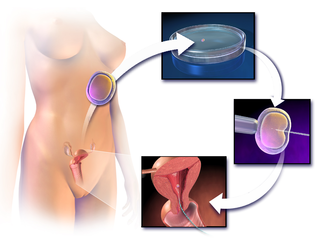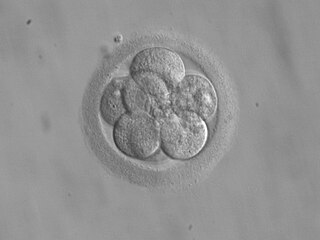Related Research Articles

In vitro fertilisation (IVF) is a process of fertilisation where an egg is combined with sperm in vitro. The process involves monitoring and stimulating a woman's ovulatory process, removing an ovum or ova from their ovaries and letting a man's sperm fertilise them in a culture medium in a laboratory. After the fertilised egg (zygote) undergoes embryo culture for 2–6 days, it is transferred by catheter into the uterus, with the intention of establishing a successful pregnancy.

Intracytoplasmic sperm injection is an in vitro fertilization (IVF) procedure in which a single sperm cell is injected directly into the cytoplasm of an egg. This technique is used in order to prepare the gametes for the obtention of embryos that may be transferred to a maternal uterus. With this method, the acrosome reaction is skipped.

Infertility is the inability of an animal or plant to reproduce by natural means. It is usually not the natural state of a healthy adult, except notably among certain eusocial species. It is the normal state of a human child or other young offspring, because they have not undergone puberty, which is the body's start of reproductive capacity.

Artificial insemination is the deliberate introduction of sperm into a female's cervix or uterine cavity for the purpose of achieving a pregnancy through in vivo fertilization by means other than sexual intercourse. It is a fertility treatment for humans, and is a common practice in animal breeding, including dairy cattle and pigs.

Assisted reproductive technology (ART) includes medical procedures used primarily to address infertility. This subject involves procedures such as in vitro fertilization (IVF), intracytoplasmic sperm injection (ICSI), cryopreservation of gametes or embryos, and/or the use of fertility medication. When used to address infertility, ART may also be referred to as fertility treatment. ART mainly belongs to the field of reproductive endocrinology and infertility. Some forms of ART may be used with regard to fertile couples for genetic purpose. ART may also be used in surrogacy arrangements, although not all surrogacy arrangements involve ART. The existence of sterility will not always require ART to be the first option to consider, as there are occasions when its cause is a mild disorder that can be solved with more conventional treatments or with behaviors based on promoting health and reproductive habits.

Embryo transfer refers to a step in the process of assisted reproduction in which embryos are placed into the uterus of a female with the intent to establish a pregnancy. This technique - which is often used in connection with in vitro fertilization (IVF) - may be used in humans or in other animals, in which situations and goals may vary.

Surrogacy is an arrangement, often supported by a legal agreement, whereby a woman agrees to childbirth on behalf of another person(s) who will become the child's parent(s) after birth. People pursue surrogacy for a variety of reasons such as infertility, dangers or undesirable factors of pregnancy, or when pregnancy is a medical impossibility.
Third-party reproduction or donor-assisted reproduction is any human reproduction in which DNA or gestation is provided by a third party or donor other than the one or two parents who will raise the resulting child. This goes beyond the traditional father–mother model, and the third party's involvement is limited to the reproductive process and does not extend into the raising of the child. Third-party reproduction is used by couples unable to reproduce by traditional means, by same-sex couples, and by men and women without a partner. Where donor gametes are provided by a donor, the donor will be a biological parent of the resulting child, but in third party reproduction, he or she will not be the caring parent.
Egg donation is the process by which a woman donates eggs to enable another woman to conceive as part of an assisted reproduction treatment or for biomedical research. For assisted reproduction purposes, egg donation typically involves in vitro fertilization technology, with the eggs being fertilized in the laboratory; more rarely, unfertilized eggs may be frozen and stored for later use. Egg donation is a third-party reproduction as part of assisted reproductive technology.
Autologous Endometrial Coculture is a technique of assisted reproductive technology. It involves placing a patient’s fertilized eggs on top of a layer of cells from her own uterine lining, creating a more natural environment for embryo development and maximizing the chance for an in vitro fertilization (IVF) pregnancy.

The Human Fertilisation and Embryology Act 1990 is an Act of the Parliament of the United Kingdom. It created the Human Fertilisation and Embryology Authority which is in charge of human embryo research, along with monitoring and licensing fertility clinics in the United Kingdom.

Oocyte cryopreservation is a procedure to preserve a woman's eggs (oocytes). This technique has been used to postpone pregnancy. When pregnancy is desired, the eggs can be thawed, fertilized, and transferred to the uterus as embryos. Several studies have shown that most infertility problems are due to germ cell deterioration related to aging. The procedure's success rate varies depending on the age of the woman,, as well as depending on health and genetic indicators. In 1986, the first human birth of oocyte cryopreservation was reported.
Poor ovarian reserve is a condition of low fertility characterized by 1): low numbers of remaining oocytes in the ovaries or 2) possibly impaired preantral oocyte development or recruitment. Recent research suggests that premature ovarian aging and premature ovarian failure may represent a continuum of premature ovarian senescence. It is usually accompanied by high FSH levels.
Fertility tourism is the practice of traveling to another country or jurisdiction for fertility treatment, and may be regarded as a form of medical tourism. A person who can become pregnant is considered to have fertility issues if they are unable to have a clinical pregnancy after 12 months of unprotected intercourse. Infertility, or the inability to get pregnant, affects about 8-12% of couples looking to conceive or 186 million people globally. In some places, rates of infertility surpass the global average and can go up to 30% depending on the country. Areas with lack of resources, such as assisted reproductive technologies (ARTs), tend to correlate with the highest rates of infertility.
Sperm donation is the provision by a man of his sperm with the intention that it be used in the artificial insemination or other "fertility treatment" of one or more women who are not his sexual partners in order that they may become pregnant by him. Where pregnancies go to full term, the sperm donor will be the biological father of every baby born from his donations. The man is known as a sperm donor and the sperm he provides is known as "donor sperm" because the intention is that the man will give up all legal rights to any child produced from his sperm, and will not be the legal father. Sperm donation may also be known as "semen donation".
Religious response to assisted reproductive technology deals with the new challenges for traditional social and religious communities raised by modern assisted reproductive technology. Because many religious communities have strong opinions and religious legislation regarding marriage, sex and reproduction, modern fertility technology has forced religions to respond.
Unexplained infertility is infertility that is idiopathic in the sense that its cause remains unknown even after an infertility work-up, usually including semen analysis in the man and assessment of ovulation and fallopian tubes in the woman. It is usually an exercise in excluding all possible causes before making a diagnosis, however the age of the female partner as well as the duration of infertility are often the most scrutinized characteristics of any infertility case.
Cryopreservation of embryos is the process of preserving an embryo at sub-zero temperatures, generally at an embryogenesis stage corresponding to pre-implantation, that is, from fertilisation to the blastocyst stage.
Repeated implantation failure (RIF) is the repeated failure of the embryo to implant onto the side of the uterus wall following IVF treatment. Implantation happens at 6–7 days after conception and involves the embedding of the growing embryo into the mothers uterus and a connection being formed. A successful implantation can be determined by using an ultrasound to view the sac which the baby grows in, inside the uterus.

Lesbian, gay, bisexual, and transgender people people wishing to have children may use assisted reproductive technology. In recent decades, developmental biologists have been researching and developing techniques to facilitate same-sex reproduction.
References
- ↑ "Shared motherhood: The amazing way lesbian couples are having babies". Cosmopolitan. 14 February 2018. Retrieved 21 March 2018.
- ↑ Klatsky, Dr Peter (22 June 2017). "Co-Maternity And Reciprocal IVF: Empowering lesbian parents with options". Huffington Post. Retrieved 21 March 2018.
- 1 2 Marina, S.; Marina, D.; Marina, F.; Fosas, N.; Galiana, N.; Jove, I. (9 February 2010). "Sharing motherhood: biological lesbian co-mothers, a new IVF indication". Human Reproduction. 25 (4): 938–941. doi: 10.1093/humrep/deq008 . PMID 20145005.
- 1 2 3 4 5 6 7 8 "Reciprocal IVF | LGTBQ Families | Reproductive Science Center NJ". Reproductive Science Center of New Jersey. Retrieved 2021-12-02.
- 1 2 3 "Reciprocal IVF". RESOLVE: The National Infertility Association. 27 August 2021. Retrieved 2021-12-02.
- ↑ "What is ovarian stimulation? - Process, medications and symptoms". inviTRA. 2022-02-21. Retrieved 2022-03-11.
- 1 2 3 "Reciprocal IVF – What Lesbian Couples Need to Know | WINFertility". www.winfertility.com. 2 March 2016. Retrieved 2021-12-05.
- ↑ "Intracytoplasmic sperm injection (ICSI) | HFEA". www.hfea.gov.uk. Retrieved 2022-03-11.
- ↑ "Reciprocal IVF for Lesbian Couples". www.gayivf.com. Retrieved 2021-12-08.
- ↑ "Embryo Transfer". American Pregnancy Association. 2018-04-25. Retrieved 2022-03-11.
- 1 2 "Reciprocal IVF - Northern California Fertility Medical Center". Northern California Fertility Medical Center - Sacramento IVF. 2019-06-04. Retrieved 2021-12-07.
- 1 2 3 4 5 Fertility, C. N. Y. (14 June 2021). "Reciprocal IVF: What It Is, How It Works & What It Costs" . Retrieved 2021-12-02.
- ↑ Greenwald, Phoebe; Dubois, Bethany; Lekovich, Jovana; Pang, John Henry; Safer, Joshua (2021-06-16). "Successful In Vitro Fertilization in a Cisgender Female Carrier Using Oocytes Retrieved From a Transgender Man Maintained on Testosterone". AACE Clinical Case Reports. 8 (1): 19–21. doi:10.1016/j.aace.2021.06.007. ISSN 2376-0605. PMC 8784719 . PMID 35097196. S2CID 236315482.
- 1 2 3 4 5 Fertility, C. N. Y. (14 June 2021). "Reciprocal IVF: What It Is, How It Works & What It Costs" . Retrieved 2021-12-07.
- ↑ Vilella, Felipe; Moreno-Moya, Juan M.; Balaguer, Nuria; Grasso, Alessia; Herrero, Maria; Martínez, Sebastian; Marcilla, Antonio; Simón, Carlos (2015-09-15). "Hsa-miR-30d, secreted by the human endometrium, is taken up by the pre-implantation embryo and might modify its transcriptome". Development. 142 (18): 3210–3221. doi: 10.1242/dev.124289 . ISSN 0950-1991. PMID 26395145. S2CID 10407069.
- ↑ Zuccarello, D., Sorrentino, U., Brasson, V. et al. Epigenetics of pregnancy: looking beyond the DNA code. J Assist Reprod Genet 39, 801–816 (2022). doi:10.1007/s10815-022-02451-x
- ↑ "▷ Epigenetic Inheritance in the ROPA Method: What you should know". 6 April 2023.
- 1 2 3 4 "Reciprocal IVF". RESOLVE: The National Infertility Association. 27 August 2021. Retrieved 2021-12-07.
- ↑ "What is reciprocal IVF, and how can it benefit LGBTQ couples?". Extend Fertility. 2019-06-20. Retrieved 2021-12-08.
- ↑ Bodri, D.; Nair, S.; Gill, A.; Lamanna, G.; Rahmati, M.; Arian-Schad, M.; Smith, V.; Linara, E.; Wang, J. (February 2018). "Shared motherhood IVF: high delivery rates in a large study of treatments for lesbian couples using partner-donated eggs". Reproductive Biomedicine Online. 36 (2): 130–136. doi: 10.1016/j.rbmo.2017.11.006 . ISSN 1472-6491. PMID 29269265.
- ↑ PFCLA. "Reciprocal IVF: Success Rates and Outcomes". www.pfcla.com. Retrieved 2021-12-02.
- ↑ "NF v R [2023] HKCFI 2233". HKLII. Retrieved 28 August 2024.
- ↑ Tsang, Frances (9 October 2023). "Lesbian Couple's Victory in Recent IVF Case in Hong Hong". Hugill & Ip Solicitors. Retrieved 28 August 2024.